MG Abingdon – A New Direction Part 2

 Immediately after his incredible run on the newly completed stretch of German Autobahn at Dessau in June 1939,where he achieved just over 200mph in his 1100cc engined MG, EX135, Goldie Gardner had the car shipped back to Abingdon. Shortly after its return, Kim and Goldie hatched a plan to go back to Dessau the following year with a 750cc version of this versatile little engine, to attack the Class H records.
Immediately after his incredible run on the newly completed stretch of German Autobahn at Dessau in June 1939,where he achieved just over 200mph in his 1100cc engined MG, EX135, Goldie Gardner had the car shipped back to Abingdon. Shortly after its return, Kim and Goldie hatched a plan to go back to Dessau the following year with a 750cc version of this versatile little engine, to attack the Class H records.
Meanwhile, Kimber, never one to miss an opportunity, sent the car out around the country on a tour of selected MG showrooms. At the outbreak of war the car was quickly returned to Abingdon where it was stored for the duration in the basement of the West St Helens Street premises along with a great deal of other valuable equipment.
No sooner had hostilities been brought to an end than Goldie Gardner was champing at the bit to go record breaking again. With Kim no longer in the driving seat at Abingdon this could have been a problem but fortunately Lord Nuffield gave the proposal his full support. Thankfully EX1 35 had escaped the serious fire that had destroyed much of the St Helens premises in 1944, although his 1500cc engine and the two Shorrock superchargers had not been so lucky. Nevertheless, the 750cc engine had survived, although needing quite a bit of further work; and an approach to Chris Shorrock saw two new superchargers put in hand. Finding a suitable location in which to run the car, however, proved to be rather more difficult. For various reasons their 1939 location of Dessau was now out of the question and a section of ltalian Autostrada identified by Count ‘Johnny’ Lurani proved to be unsuitable after a test run. Just when the situation was beginning to look hopeless, a stretch of unused motorway was ‘discovered’ in Belgium and arrangements were quickly put in hand.
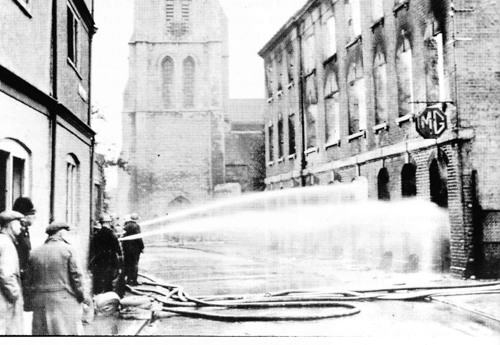
After delays due to bad weather, and with his team around him, Goldie elected to make his run on October 30, 1946. Keeping the speed at a steady 154mph on the outward leg the car ran like clockwork. On the return run Goldie gave the little engine its head and noted that the rev counter was showing 8,300rpm; the equivalent of 165mph! The official figures showed that he had beaten the previous records (held incidentally by Bobby Kohlraush in the Magic Midget) by a margin of some 20mph.
Goldie continued to break records on the Belgium motor road on an annual basis, using engines from 350cc up to a 2.0 litre Jaguar power unit. ln 1951 he was persuaded to take the car to the Bonneville Salt Flats in the USA. ln order to help boost sales of the TD in America the car was fitted with a supercharged 1250cc XPAG engine. A total of six international long distance records and ten American national records were broken but an attempt on the short distance records had to be abandoned due to a combination of bad weather and faulty timing equipment. Returning to Utah in 1952, Goldie bagged a couple of mid-distance records with the XPAG engine but failed by a whisker to beat his 1939 speeds for the sprint distances. His speeds of a fraction over 202mph for the mile and kilometre were, however, sufficient to stand as American records, whilst making EX135 the fastest ever TD powered MG.
Back in 1947 a young man by the name of Dick Jacobs began racing an MG TC just for the fun of it. Enjoying it enormously, he continued in much the same vein the following year during which he encountered a fellow competitor by the name of George Phillips. Although not realizing it at the time, both men would become indelibly linked to the future of the MG sports car. Aware that their progress on the track was limited by funding, they approached John Thornley, now Abingdon’s deputy general manager, to request company backing to enter two TCs in the 1949 BRDC ‘Daily Express’ production car race at Silverstone. Not only did he agree to this request (after much arm twisting!) but in fact provided a third car, which would be driven by Ted Lund. The outcome was that the three cars finished the race in fifth, sixth and seventh places in the 1500cc class. John Thornley seemed well satisfied with this result as the cars were without doubt the most standard cars in the race and were fully equipped even including side screens. As the result of this the company decided to enter a team of three TDs for both the Silverstone ‘Daily Express’ and the Ulster TT the following year. Once again the three cars acquitted themselves well at Silverstone, managing second, third and fourth behind an HRG in the 1500cc class. The outcome of the TT some three weeks later was that the three TDs were placed first (Jacobs), second (Phillips) and third (Lund) in their class. For its part the company decided to rest on its laurels for 1951 with the three cars being sold to their respective drivers.
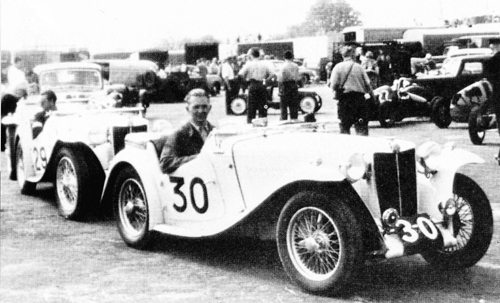
Looking for a new car to race in 1951, Jacobs decided to build an MG special. Whilst he needed this to be an MG he wanted to build his own lightweight body on it. He approached Harry Lester who was at that time building specials utilizing a lightweight tubular chassis, clothed in a fibreglass body and using an MG engine. Lester declined to supply just a chassis so Dick had a word with John Thornley. After thinking it over, Thornley agreed that Syd Enever would supply him with a special one off chassis. This is listed in the EX Register as ‘EX171 TD Converted to Road Racing (Dick Jacobs)’. This was basically a TD chassis with special rear suspension, which has been described by Jacobs as ‘Enever’s interpretation of the Fiat 1400’s coil spring set up’ and made ready for collection in December 1950. There is evidence that Syd was looking at a new racing body too, but as Dick Jacobs was keen to build his own this reached no further than the drawing stage. The new body was built in Dick’s own workshops and the finished car entered for the Easter Goodwood meeting. Unfortunately the car understeered so badly during practice that it was deemed too dangerous to race. Obviously Syd’s design needed a great deal more development. Dick and his staff continued to work on the car and gradually it was tamed, and the handling improved. Meanwhile Jacobs had continued to race his Mk 2TD and reluctantly decided to sell the ‘special’ after receiving a very generous offer for it at the Manx Cup Race.
In the meantime, over at Cowley, Gerald Palmer was settling into his new job as MG, Riley and Wolseley design supremo. Initially charged with designing four new body styles for the three marques it soon became apparent that this was not a viable propositioin. Palmer decided to reduce this to two basic models, a four-seater saloon (MG and Wolseley) and a six-seater saloon (Wolseley and Riley). His first priority was to design a new MG saloon re replace the rapidly aging Y-type. Working at one quarter scale, he produced a series of highly detailed drawings that were then passed into the small MG and Riley design office to be redrawn full size before being shipped over the road to the Pressed Steel Company for tooling design and manufacture. Palmer had chosen to go for the monocoque body/chassis approach for the new car, thus making it the first MG not to have a separate chassis. Although a larger car all round than the Y-type it would of necessity need to carry over the well tried and tested 1250cc XPAG engine that had been an MG staple for so many years. Although using almost all of the same body pressings, the Wolseley version would sit a couple of inches higher off the ground and would be made to look somewhat less sporty in the hope that it would appeal to the marketing department’s image of the traditional Wolseley buyer. As the result of a Cowley boardroom decision, it was this version that first saw the light of day when it was unveiled at the 1952 London Motor Show as the Wolseley 4/44. With nothing new to display on their stand at the Show and with TD sales beginning to fall off rapidly, particularly in the States, MG were once again feeling rather left out.
The June 1, 1951 issue of Autosport carried a full page photo shoot of a special aerodynamic, aluminum-bodied TD, listed as EXI72 but better known by its registration number UMG 400, supplied (and manufactured) by the MG Car Company, which their chief photographer, George Phillips would be driving at Le Mans in just a few weeks time. The exclusive handiwork of Syd Enever, the shape of the body had been developed from that of the Railton body on Goldie Gardner’s EXl35 which had proved on many occasions that speed wasn’t just a matter of raw power.
Unfortunately, around three hours into the race the engine, also supplied by MG, broke a valve which put paid to any further participation in the event. Phillips was livid and bitter recriminations followed which put paid to any further cooperation between George and the factory, with UMG 400 being quietly withdrawn from any further racing.
Enever, however, was not prepared to let the matter rest there. There had been a serious shortcoming in the design of EX 172 that he was determined to rectify. Using the TD chassis meant that the driver’s seat was positioned on top of the sidemember. The low profile of the scuttle and the deeply cutaway doors combined to make the driver appear to be sitting uncomfortably high in the cockpit. Syd came up with a simple solution. He designed a chassis with the sidemembers swept out to the sills rearward of the bulkhead, ensuring that the driver could now be positioned within, rather than on, the frame. Having sketched out roughly what he wanted, he gave his young trainee draughtsman, Roy Brocklehurst, the job of drawing it up full size. He then had two complete chassis frames, one RHD and one LHD, made up in the small experimental shop located on the side of the main production area. The RHD chassis was built up using an XPAG engine and many TD components, suitably modified where necessary, and shipped up to Morris Bodies Branch in Coventry to have a body fitted. Armed only with UMG 4OO and a quarter scale drawing by another of Syd’s staff, Dennis Drury (a specifications clerk who’d had some experience of technical drawing), Eric CarteL Bodies Branch’s one and only designer draughtsman, set about creating EX175, the first proper MGA prototype. Once Eric had completed his full size drawings they were given to the Bodies Branch experimental shop where a one off steel shell was made. The end result, painted a deep maroon (possibly a Riley colour) and trimmed in a beige colour was then shipped back to Abingdon and registered as HMO 6. John Thornley could hardly contain his excitement and hurriedly arranged for himself and Syd to show it to Leonard Lord, now Chairman of the newly created British Motor Corporation; the result of a merger between Austin and Morris earlier that year. Their timing could hardly have been worse. Unfortunately for MG, Lord had, only a month or two earlier at the 1952 Motor Show, entered into a deal with Donald Healey to produce his brand new Austin engined Healey 100. Using the A90’s 2.6 litre engine and featuring superb styling, this, Lord decreed, would be the new corporate sports car. All MG could do was to go back to see what they could salvage from the ageing TD.
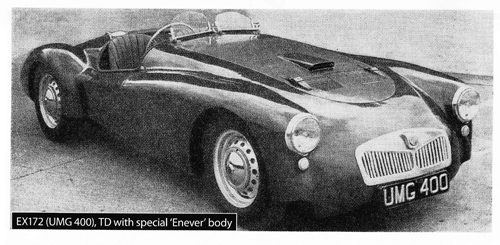
With their backs to the wall, Cecil Cousins took the initiative once again and asked his boys what they could do without spending large amounts of money. Taking a TD they raked the radiator back and got ‘tinny’ Billy Wilkins to fair the headlamps into the wings. They then increased the rake on the back end to match the front, made some cosmetic changes to the instrument panel and equipped the car with bucket seats. This ‘prototype’ was then sent over to Cowley to be drawn up for production; the job once again falling to Jim O’Neill.
Introduced at the 1953 Motor Show, the TF, as it had now been named, was not the immediate success that had been hoped for. The opposition from other British manufacturers such as the Triumph TR2 clearly indicated that MG, for so long the market leader, could no longer cut the mustard. There was, however, a new MG of sorts sharing the stand with the TF – the ‘Z’ Magnette. This car too came in for its share of criticism from the dyed-in-the-wool MG enthusiasts, who claimed that they were being fobbed off with a rebadged Wolseley, unaware of course that Gerry Palmer had originally designed the car as an MG. Nevertheless this new Magnette had quite a lot going for it. For a start it featured the new 1500cc Austin designed BMC engine giving markedly more horsepower than the old XPAG unit. lt also handled well, was comfortable and had plenty of kerb appeal. Abingdon were more than happy to have it. Over at Cowley, Gerry Palmer was also putting the finishing touches to the Riley Pathfinder, another car that was destined for the Abingdon production lines.
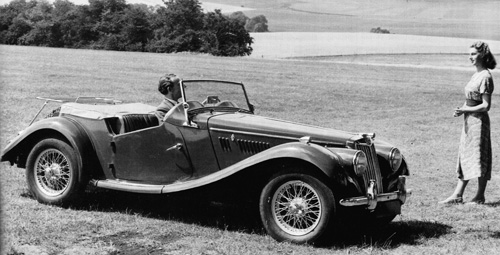
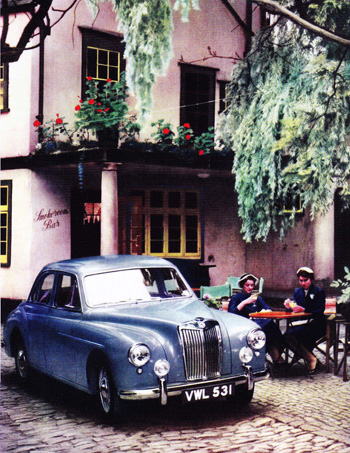
At this point George Eyston, MG’s original record breaker, who had been working closely with Goldie on the salt flats, decided that he would like to pick up the baton again and go record breaking for MG once more. Eyston, a man of enormous charm (who was already at this stage involved in record breaking with Austin Healey), visited the newly knighted Sir Len Lord with a request that Abingdon be allowed to provide him with a suitable car for this purpose. As a director of Castrol he was also able to offer a degree of funding for this venture. His charm (and money?) won the day and Lord agreed to his request. The big problem was what car to use. EX135 was completely out of the question. John Thornley had purchased the car from Goldie for the Company and would never sanction its use by anyone else. EX175 was tested in the wind tunnel at Longbridge but was found to be unsuitable. The compromise solution was to requisition the unused LHD chassis from EX175 and clothe it in a new body shell. To carry out the design of the new body, Syd requested the assistance of a draughtsman from the MG and Riley office at Cowley and was allocated a young chassis engineer by the name of Terry Mitchell, who had been working on the Pathfinder rear suspension. Working in the semblance of a drawing office at Abingdon, Terry was soon getting to grips with his task. “Make it like EX135 only different” was his only instruction from Syd! Fortunately the body for Goldie’s car had been fully detailed so Terry was able to use this as a basis. A full size plywood ‘eggcrate’ was made in the works from Terry’s drawing and this was then sent up to Midland Sheet Metal for them to work their magic, whilst Abingdon readied the engine and chassis.

To be continued ….
Our thanks once again to Andy Knott, Editor Safety Fast, and author, Peter Neal, for their permission to reprint this article.

